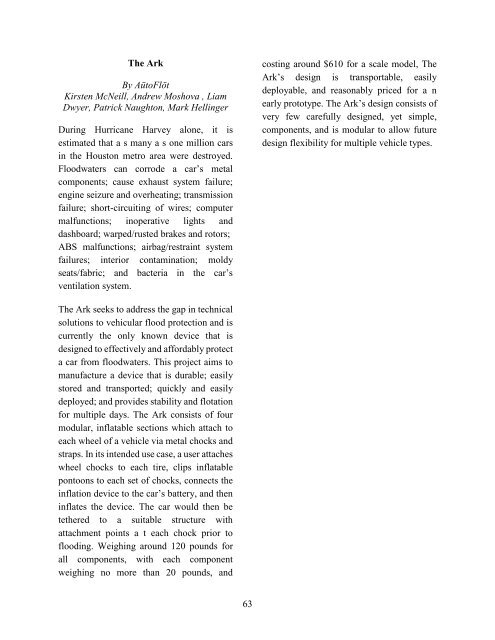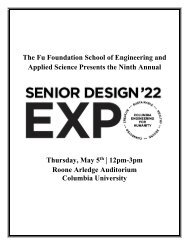Senior Design Expo 2019
The Senior Design Expo, held annually in May at Columbia University, is an opportunity for Columbia Engineering students to showcase what they have learned in their foundational math and science courses together with their engineering courses in innovative, creative, and purposeful designs and prototypes. Each year the Expo showcases more than 60 projects across all nine departments. Projects have included cutting-edge robotics, the New York City subway system, language technology, proposals for bridges to span the Hudson river, and much more.
The Senior Design Expo, held annually in May at Columbia University, is an opportunity for Columbia Engineering students to showcase what they have learned in their foundational math and science courses together with their engineering courses in innovative, creative, and purposeful designs and prototypes. Each year the Expo showcases more than 60 projects across all nine departments. Projects have included cutting-edge robotics, the New York City subway system, language technology, proposals for bridges to span the Hudson river, and much more.
Create successful ePaper yourself
Turn your PDF publications into a flip-book with our unique Google optimized e-Paper software.
The Ark<br />
By AütoFlöt<br />
Kirsten McNeill, Andrew Moshova , Liam<br />
Dwyer, Patrick Naughton, Mark Hellinger<br />
During Hurricane Harvey alone, it is<br />
estimated that a s many a s one million cars<br />
in the Houston metro area were destroyed.<br />
Floodwaters can corrode a car’s metal<br />
components; cause exhaust system failure;<br />
engine seizure and overheating; transmission<br />
failure; short-circuiting of wires; computer<br />
malfunctions; inoperative lights and<br />
dashboard; warped/rusted brakes and rotors;<br />
ABS malfunctions; airbag/restraint system<br />
failures; interior contamination; moldy<br />
seats/fabric; and bacteria in the car’s<br />
ventilation system.<br />
costing around $610 for a scale model, The<br />
Ark’s design is transportable, easily<br />
deployable, and reasonably priced for a n<br />
early prototype. The Ark’s design consists of<br />
very few carefully designed, yet simple,<br />
components, and is modular to allow future<br />
design flexibility for multiple vehicle types.<br />
The Ark seeks to address the gap in technical<br />
solutions to vehicular flood protection and is<br />
currently the only known device that is<br />
designed to effectively and affordably protect<br />
a car from floodwaters. This project aims to<br />
manufacture a device that is durable; easily<br />
stored and transported; quickly and easily<br />
deployed; and provides stability and flotation<br />
for multiple days. The Ark consists of four<br />
modular, inflatable sections which attach to<br />
each wheel of a vehicle via metal chocks and<br />
straps. In its intended use case, a user attaches<br />
wheel chocks to each tire, clips inflatable<br />
pontoons to each set of chocks, connects the<br />
inflation device to the car’s battery, and then<br />
inflates the device. The car would then be<br />
tethered to a suitable structure with<br />
attachment points a t each chock prior to<br />
flooding. Weighing around 120 pounds for<br />
all components, with each component<br />
weighing no more than 20 pounds, and<br />
63








